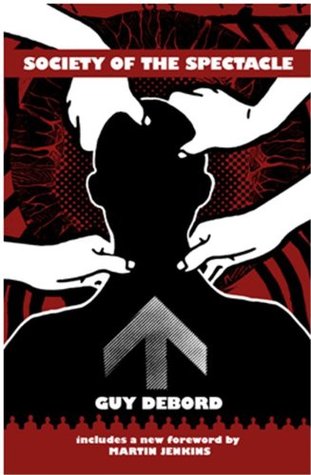More on this book
Community
Kindle Notes & Highlights
The spectacle presents itself as a vast inaccessible reality that can never be questioned. Its sole message is: “What appears is good; what is good appears.” The passive acceptance it demands is already effectively imposed by its monopoly of appearances, its manner of appearing without allowing any reply.
Eric Z liked this
The spectacle is the material reconstruction of the religious illusion.
The reigning economic system is a vicious circle of isolation. Its technologies are based on isolation, and they contribute to that same isolation. From automobiles to television, the goods that the spectacular system chooses to produce also serve it as weapons for constantly reinforcing the conditions that engender “lonely crowds.”
The spectacle is the map of this new world, a map that is identical to the territory it represents.
Once his workday is over, the worker is suddenly redeemed from the total contempt toward him that is so clearly implied by every aspect of the organization and surveillance of production, and finds himself seemingly treated like a grownup, with a great show of politeness, in his new role as a consumer.
The society that bears the spectacle does not dominate underdeveloped regions solely by its economic hegemony. It also dominates them as the society of the spectacle.
Consumers are filled with religious fervor for the sovereign freedom of commodities whose use has become an end in itself. Waves of enthusiasm for particular products are propagated by all the communications media. A film sparks a fashion craze; a magazine publicizes night spots which in turn spin off different lines of products.
Like the old religious fetishism, with its convulsionary raptures and miraculous cures, the fetishism of commodities generates its own moments of fervent exaltation. All this is useful for only one purpose: producing habitual submission.
Each new lie of the advertising industry is an admission of its previous lie.
The more powerful the class, the more it claims not to exist, and its power is employed above all to enforce this claim.
Although fascism rallies to the defense of the main icons of a bourgeois ideology that has become conservative (family, private property, moral order, patriotism), while mobilizing the petty bourgeoisie and the unemployed workers who are panic-stricken by economic crisis or disillusioned by the socialist movement’s failure to bring about a revolution, it is not itself fundamentally ideological. It presents itself as what it is — a violent resurrection of myth calling for participation in a community defined by archaic pseudovalues: race, blood, leader.
The succession of generations within a natural, purely cyclical time begins to be replaced by a linear succession of powers and events. This irreversible time is the time of those who rule, and the dynasty is its first unit of measurement.
The bourgeoisie is the first ruling class for which work is a value. And the bourgeoisie, which suppresses all privilege and recognizes no value that does not stem from the exploitation of labor, has appropriately identified its own value as a ruling class with labor, and has made the progress of labor the measure of its own progress.
Everybody is urged to economize on their “youth-capital,” though such capital, however carefully managed, has little prospect of attaining the durable and cumulative properties of economic capital. This social absence of death coincides with the social absence of life.
Tourism — human circulation packaged for consumption, a by-product of the circulation of commodities — is the opportunity to go and see what has been banalized.
The self-destruction of the urban environment is already well under way. The explosion of cities into the countryside, covering it with what Mumford calls “a formless mass of thinly spread semi-urban tissue,” is directly governed by the imperatives of consumption. The dictatorship of the automobile — the pilot product of the first stage of commodity abundance — has left its mark on the landscape with the dominance of freeways, which tear up the old urban centers and promote an ever-wider dispersal. Within this process various forms of partially reconstituted urban fabric fleetingly crystallize
...more
The landscape of the “new cities” inhabited by this technological pseudopeasantry is a glaring expression of the repression of historical time on which they have been built. Their motto could be: “Nothing has ever happened here, and nothing ever will.”
When art, which was the common language of social inaction, develops into independent art in the modern sense, emerging from its original religious universe and becoming individual production of separate works, it too becomes subject to the movement governing the history of all separate culture. Its declaration of independence is the beginning of its end.
Ideas improve. The meaning of words plays a role in that improvement. Plagiarism is necessary. Progress depends on it. It sticks close to an author’s phrasing, exploits his expressions, deletes a false idea, replaces it with the right one.


